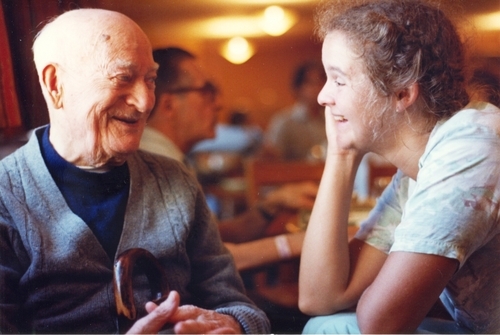Cave, John Clifford: my Army recollections (August 14, and 24, 1978)
Interviewer: Main, Chris D.
Interviewee: Cave, John Clifford, b. 1907
Rank: Lieutenant-Colonel.
ABSTRACT: Lt.-Col. John Clifford Cave Princess Patricia's Canadian Light Infantry The Sherbrooke Fusiliers Regiment (27th Armoured Regiment) Cave_J_0027_01.mp3 (Side 1) Born on Dec. 24, 1907 in Birkenhead, Cheshire, England. Parents emigrated to Ontario, then Winnipeg. As a boy, saw the rioting in the Winnipeg General Strike of 1919. After serving in a cadet corps and the militia for a number of years, Cave joined Princess Patricia's Canadian Light Infantry (P.P.C.L.I.) in Jan. 1925. Explains recruit standards of that time. Modest provision of equipment, uniforms, and food were the norm. Marriage for a soldier was difficult, since the payment of the marriage allowance was restricted to about ten percent of the nominal roll of the battalion. The alternative was a fifteen dollar per month ration allowance. Gives the organization of the P.P.C.L.I. in the 1920's. Details of training on the Vickers machine-gun. (20:00) Gun drill explained. Battalion still provided with some horse-drawn equipment. In 1938 posted as a sergeant-instructor to the First Canadian Army Tank School in London, Ont. Later moved to Camp Borden. Mentions original P.P.C.L.I. officers, great "family" orientation, Shorty Colquhoun, etc. The price of food, social life, much sports and physical training. (45:00) Cave_J_0027_02.mp3 Promotion depended upon educational attainment which was provided to interested troops. Extra pay was available to those who improved themselves. Peacetime discipline was stern; single men coped best. By 1939 somewhat better equipment was becoming available. Company sergeant-major instructor by now. In 1940 commissioned into the P.P.C.L.I. (10:00) Comments on various armoured vehicles, American Renaults, early Rams. Promoted to major in 1941. (30:00) Trained in tanks at Fort Knox in the United States, after travelling there as civilians. Wanting to go overseas, he eventually obtained a posting to the Sherbrooke Fusiliers Regiment (S.F.R.). The account jumps ahead to overseas training, battle casualty in France, Armoured School. (45:00) Discusses conscription. (48:00) Cave_J_0027_03.mp3 (Side 2) Returns to thoughts on training in Canada. French Canadian troops could be better than average if handled properly. Recruiting difficulties in Quebec. In the S.F.R. the working language was English. French Canadians gradually reduced to about forty percent of strength. Some problems of education: Quebec schools could be deficient in mathematics and science. Most effective tank operators were prairie farmers and northern miners. As acting commanding officer of the regiment, had some administrative problems. Intensive training required, as they were less well trained than the other regiments in their brigade. Weeded out some two hundred men. (12:00) Took the regiment overseas, then posted to a senior officers school. Returned to the S.F.R. as second-in-command. Comments on pre-invasion duties. (25:00) D-Day assault and preparations. Fighting in Normandy. Carpiquet. Describes loading tanks on landing craft, tanks on June 5, 1944. (45:00) Cave_J_0027_04.mp3 D-Day casualties not as high as expected. Effectiveness of tanks and guns. Explains the phrase "infantry cum tanks". Originally applied to infantry tanks such as the Churchill which were designed to support infantry attacks. Heavy fighting: only nineteen tanks operational in the regiment on the night of D+1. Many quickly repaired or replaced. (20:00) Describes his tank being hit by artillery. After thirteen days, exhausted by lack of sleep and strain, he was evacuated to hospital in England. Staff College in the spring of 1945. Comments on Maj.-Gen. Worthington. Returned to Canada. General staff officer, grade 2 in Regina, later as a lieutenant-colonel was general staff officer, grade 1 in Ottawa. Last posting in Victoria. Retired. (43:00)
An interview/narrative of John Clifford Cave's experiences during World War II. Lieutenant-Colonel Cave served with Princess Patricia's Canadian Light Infantry and the Sherbrooke Fusiliers Regiment (27th Armoured Regiment). Interview took place on August 14 and 24, 1978.
- In Collection:
- Vickers machine gun
- Canada--Canadian Army--Military life
- Canada--Canadian Army--Drill and tactics
- French-Canadians
- Operational readiness (Military science)
- World War, 1939-1945--Personal narratives, Canadian
- Tanks (Military science)
- Cave, John Clifford, b. 1907.--Interviews
- Canada--Canadian Army--History--1919-1945
- Gunners--Training of
- Canada--Canadian Army--Princess Patricia's Canadian Light Infantry-- Battalion, 1st
- Armored vehicles, Military
- Canada--Canadian Army-- Sherbrooke Fusiliers Regiment
- Canada--Canadian Army--Princess Patricia's Canadian Light Infantry
- Canada--Canadian Armed Forces--Royal Canadian Armoured Corps
- World War, 1939-1945--Campaigns--France--Normandy
- 4 sound recordings (MP3)
- 60.10867, -113.64258
- 52.16045, -0.70312
- One original sound tape reel (ca. 180 min.) : 1 7/8 ips, 2 track, mono. ; 2 sound cassette copies : standard, mono. in Special Collections.
- Canadian Military Oral History Collection
- CJC_027
- Special Collections Finding Aid: https://search.archives.uvic.ca/reginald-herbert-roy-fonds
- May 17, 2007
- Digital sound recording in .wav format at 16 bits and 22 kHz. In .mp3 format at 64 kbps and 22 kHz. Digitized by AN, technical and cataloguing metadata provided by JF and JP. Transferred from audio reel to audio cassette between 1987-1997. Interview migrated to digital format for UVic Special Collections in 2007. Migration metadata by KD and MT.
- Rights
- This interview has been posted with the understanding that it may be used for research purposes only. Should the interviewee or their heirs have any objections to this interview being accessible on the Internet, it will be removed promptly. Contact UVic Special Collections for permission if using for other than research purposes: speccoll@uvic.ca
- DOI
| Thumbnail | Title | Date Uploaded | Actions |
|---|---|---|---|
|
|
SC141_MilitaryOralHistory_GenericThumbnail |
|
|

|
Cave_J_0027_01.mp3 |
|
|

|
Cave_J_0027_02.mp3 |
|
|

|
Cave_J_0027_03.mp3 |
|
|

|
Cave_J_0027_04.mp3 |
|